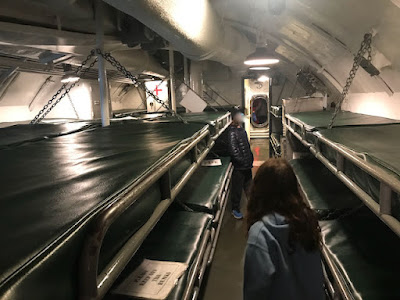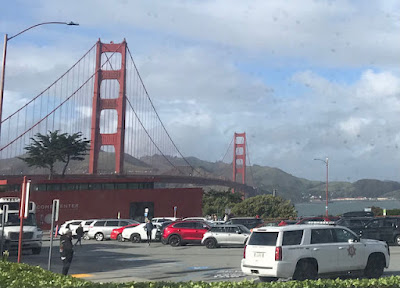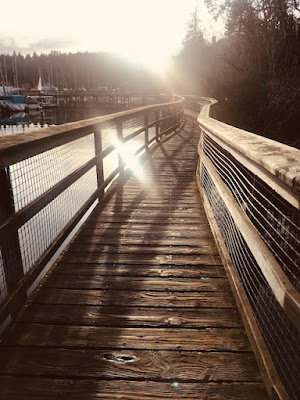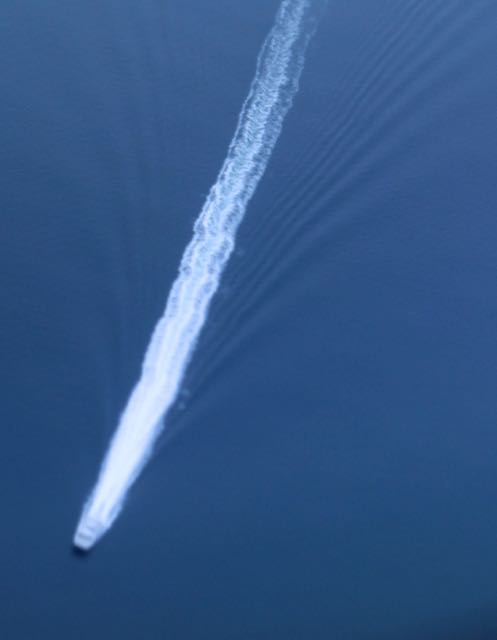Yesterday I had a chance to meet John Duffy, the former manager and planning director of Mat-su. I asked him about his thoughts on the Knik Arm bridge and the ferry that has been a white elephant for the borough since building a ferry dock on the Anchorage side never happened.
His response was that the ferry was a good idea and the Knik Arm bridge is a bad idea. But the comment he made that most caught my attention was that
"there has never been a bridge built that wasn't preceded by a ferry." He even volunteered to give me $100 if I could find one.
Did he have any backup evidence on this? Is there a book on this? An article? Is there a way to find this on google without checking bridge by bridge? He didn't know of any, but he said he just knew this because he worked in this area. He did add that all the contractors who looked at building the Knik Arm bridge said that they needed a ferry to get supplies, employees, and inspectors across the gap while building the bridge, that they weren't going to do the five hour round-trip drive. That made sense.
OK, I realize that while
Duffy didn't initiate this project, he did inherit it and promoted it for
a while. I'd never heard before that bridges don't get built unless there are
ferries first. If this is true, what does it suggest about the future of the Knik Arm bridge? Duffy's role might give him an incentive to make it look like a good deal,
but it also gives him some inside knowledge. And, as I
said, the idea that bridges don't get built unless there are ferries
first is new to me, and I suspect to others. Of the many projects in Alaska
that haven't worked out, this one had acquired a pretty pricey boat for
nothing and merely needed a port on each end - a minor task
compared to, say the Knik Arm bridge project. If people had supported
it strongly, it could have easily happened. The question is why,
really, did the support evaporate? (I don't have the answer today, but it's something we should be asking.)
But I'm am going to offer what I've found about the idea that bridges are always preceded by ferries.
Googling The Link Between Bridges And Ferries
So I started googling. Things like 'bridges preceded by ferries," which got a number of articles about specific bridges in the US. But I wanted a larger selection. So I looked up "10 biggest bridges in the world." That got me lots of the ad-laden list sites. So I opted for Wikipedia which gave a list of countries and lists of bridges in those countries. But they tended to only talk about the bridge and not what preceded the bridge.
I changed my strategy a bit. Once I got a bridge name, I googled for the river plus crossing with ferries. This got ferries for every bridge I looked up. I've got those below. Of the 15 or so bridges I looked up, I didn't find one that wasn't preceded by ferries. That's a small sample size, but I looked at bridges in different parts of the world, old ones, new ones, big ones and small ones. I also have examples of bridges crossing different bodies of water - mostly rivers, but also bays, lakes, fjords, and canals.
A ways into my search, I did find a general statement about bridges and ferries (and fords.)
From an 1898 book titled
Science and Industry, Vol II
"Barring these disadvantages, fords and ferries are adequate for the needs of a thinly settled community; but, as population and traffic increase, there arises a demand for a safe and certain crossing of streams, whatever the state of weather and water.
This demand always precedes the bridge-building period."
Why Does This Matter?
Why am I making such a big deal about this? We've got a well paid commission that is working to set up the Knik Arm bridge. Many people think there is no need for such a bridge.
The Mat-su Borough attempted to develop a ferry at the same location. They got a great deal on an experimental ship built by the US military and they built a ferry terminal on the Mat-su side. But they couldn't get Anchorage to build a site on the Anchorage side.
Mat-su finally gave up and put the ferry up for sale.
I had assumed the Anchorage side didn't want the ferry because they were pushing the bridge and didn't want the competition. But the point Duffy was making was that you need a ferry service to demonstrate the need before you build a bridge. His point was that every bridge over water was preceded by a ferry. The Science and Industry text says that outright, but it's an old text. Below is a list of 15 bridges around the world. Every one I looked up was preceded by ferries.
Not only are ferries, apparently, important as a first sampling test of the need for a bridge, but Duffy points out that to build a bridge, you need ferries to cross the body of water to take materials, employees, and inspectors.
15 Bridges That Were Preceded By Ferries
1.
SFChronicle:
"Ferries on the San Francisco Bay predate cable cars in the city by nearly 50 years, starting with John Reed,
who ran a sailboat from Sausalito to San Francisco in 1826. His
business didn’t last long. The American Indians, who paddled across the
bay, were faster and much more reliable.
Regular ferry service started in 1851, and the
popularity exploded in 1907, when several ferry companies consolidated
into Northwestern Pacific (taken over by Southern Pacific in 1928).
Southern Pacific’s 43 boats in 1930 were reportedly the largest
ferryboat fleet at the time in the world.
The local ferry companies aggressively fought the
construction of the Golden Gate Bridge and Bay Bridge, and they were
financially smart to do so. The popular bridges mortally wounded the
ferry business, and the final transbay ferry journey of the era was
completed in 1958."
Before
the Bridges: When ferry boats plied the river - See more at:
http://www.wnypapers.com/news/article/featured/2015/02/21/119687/before-the-bridges-when-ferry-boats-plied-the-river#sthash.64ZHPgcL.dpuf
Before
the Bridges: When ferry boats plied the river - See more at:
http://www.wnypapers.com/news/article/featured/2015/02/21/119687/before-the-bridges-when-ferry-boats-plied-the-river#sthash.64ZHPgcL.dpuf
2.
Niagra Wheatfield Tribune Grand Island, Niagra Falls NY
The push
for Island bridges
Grand Island was purchased from the
Senecas in 1815. Forests of oak trees drew settlers for the Island's valuable
lumber. Farms then flourished and the Island became a popular summer resort
with sprawling, gracious estates, private clubs and summer homes. It officially
became a town in 1852. Two ferries provided transportation to and from the
Island before the bridges were built. One launched from the former Bedell House
in Ferry Village and the other from the site of the current Byblos Niagara Resort
& Spa.
Luther's grandfather, Henry Long, went to
Washington, D.C., in 1898 to make a case for bridge construction, but he died
in 1925 without seeing his dream come true. A decade later, Island
schoolchildren were bused to the South Grand Island Bridge for its grand
opening, where noted urban planner Robert Moses and other dignitaries joined in
the celebration in 1935. Grand Island Boulevard, then called the Express
Highway, had been built in 1933-34, Luther said, to connect the two bridges.
The Congregational Church was torn down to make room for the highway to come
through. "The second set of bridges didn't come 'til the 1960s," she explained.
"But there certainly wasn't the flow of traffic that we have now."
-
See more at:
http://www.wnypapers.com/news/article/featured/2015/02/21/119687/before-the-bridges-when-ferry-boats-plied-the-river#sthash.64ZHPgcL.dpuf
"The push for Island bridges
Grand Island was purchased from the Senecas in 1815. Forests of oak trees drew settlers for the Island's valuable lumber. Farms then flourished and the Island became a popular summer resort with sprawling, gracious estates, private clubs and summer homes. It officially became a town in 1852. Two ferries provided transportation to and from the Island before the bridges were built. One launched from the former Bedell House in Ferry Village and the other from the site of the current Byblos Niagara Resort & Spa.
Luther's grandfather, Henry Long, went to Washington, D.C., in 1898 to make a case for bridge construction, but he died in 1925 without seeing his dream come true. A decade later, Island schoolchildren were bused to the South Grand Island Bridge for its grand opening, where noted urban planner Robert Moses and other dignitaries joined in the celebration in 1935. Grand Island Boulevard, then called the Express Highway, had been built in 1933-34, Luther said, to connect the two bridges. The Congregational Church was torn down to make room for the highway to come through. "The second set of bridges didn't come 'til the 1960s," she explained. 'But there certainly wasn't the flow of traffic that we have now.'"
3.
Duluth
1906 – 1910: Working Out the Bugs
In March McGilvray reported that the bridge had run perfectly since
February 6, handling two hundred to three hundred teams of horses and
thirty thousand people a day. He estimated the cost of operating the
bridge, including the $4,000 in interest on the bond, at $10,578.31. It
may not have been as big a savings from the ferry operation as
anticipated, but McGilvray’s spin on the numbers illustrates the bargain
that was the bridge: it cost the city “one-fifth of one cent per
passenger for operation, maintenance, interest, and power.” He closed
his report with a request for the city to install a telephone in the
ferry car so its operator could call for help should the car break down
in the middle of the canal. It was not granted.
4.
Idaho government webstie talks about ferries in Idaho
In the late1800’s there were hundreds of ferries operating throughout the state, but by the early 1900’s the business began to disappear. With the population growing, it made sense to build bridges across the most traveled routes. Once a bridge spanned the river, there was no need to have a ferry.
5.
Columbia River Bridge at Astoria, Oregon:
“The Columbia River span ended the last operating ferry service along the Oregon Coast Highway. The use of ferries at the mouth of the Columbia River began in 1840 when Solomon Smith, Astoria’s first schoolteacher, lashed two canoes together and carried passengers and cargo across the river.3 Ferries intermittently served the area into the beginning of the twentieth century. When the Columbia River Highway (US 30) opened a direct overland link between Portland and Astoria in 1915, automobile traffic through Astoria rose, creating pressure for more dependable ferry service. Seeing opportunity, Captain Fritz Elfving established the first commercial auto ferry service in 1921, when the Tourist I made her maiden voyage. For forty years ferries kept the traffic moving, but there were some drawbacks. For one thing, they were slow. In good weather the 4.5-mile trip took half an hour. Since the boats could hold only a limited number of vehicles, motorists often endured long waits in heavy traffic.”
6.
Chesapeake Bay.
Were there any Chesapeake Bay car ferries?
Why yes, there were once a number of ferries that crossed the
Chesapeake, and they transported automobiles and trucks from one side to
the other. They were quite popular for a time, actually.
As an example, the Virginia Ferry Corporation operated ferries that
crossed the mouth of the Chesapeake Bay. They departed from Little
Creek (on the border between Norfolk and Virginia Beach) on the western
shore to Cape Charles and Kiptopeke Beach on the Virginia Eastern Shore.
The heyday for this corporation wasn’t very long. It ran ferries in
the years after World War II and into the 1960’s according to the Chesapeake Bay Ferries website.
A much longer ferry tradition existed further up the bay in Maryland.
Ferries existed between Annapolis and Kent Island as early as the
nineteenth century. They were probably carrying automobiles by the
1920’s or 1930’s according to the Roads to the Future’s Chesapeake Bay Bridge History.
Several lines and operators existed between the Maryland Eastern Shore
and the larger portion of the state. These included the
Claiborne-Annapolis Ferry operated by a private company and the Sandy
Point-Matapeake Ferry operated by the State of Maryland
Why aren’t there any Chesapeake Bay car ferries?
That’s another question I often see in my query logs. The answer is simple: Bridges. The Chesapeake Bay Bridge Tunnel
opened in 1964, connecting the two shores of Virginia with an
innovative combination of bridge and tunnel segments. Maryland also
connected its shores with the Chesapeake Bay Bridge in 1952. They weren’t too original with the names, though. This one is just a bridge, no tunnel, as the name clearly states.
The ferries disappeared soon thereafter at both locations. They
simply couldn’t compete with the bridges. It might take an hour or two
to cross the Chesapeake Bay using a ferry after figuring in waiting,
loading, sailing and unloading. It took just a few minutes to drive
across a bridge, and travelers didn’t have to worry about sailing times
either. Ironically the traffic on the Chesapeake Bay Bridge can get so
bad on summer weekends that a ferry is starting to sound pretty attractive again.
7.
From Gulflive, the bridge at Fort Bayou, Mississippi:
Older generations know not to take for granted some of our modern
bridges, especially the four-laned ones. In generations past folks often
had to rely on ferries to cross bodies of water.
One of the earliest exits out of Ocean Springs was north on
Washington Avenue across Fort Bayou. Franco's Ferry came to be operated
there by 1875.
Quoting from a book by Chris Wiggins the article continues:
"Ferries came in all sizes and descriptions," wrote Wiggins. "For
crossings on smaller bodies of water, a rope or cable ran from one bank
to the other. "The ferry guided along this and was pulled by cranking on
a winch. For larger crossings a ferry could be propelled by a boat and
motor attached to the ferry and no permanently moored cable was
required. This was the case across the Pascagoula River, from Gautier to
Pascagoula.
"The ferry was operated under a license issued by the county, and
public documents provide a record of the rates. In 1893 the fare was:
one man on foot $.05, man and horse $.10, man and horse and cart $.15,
each driven horse or cow $.02. Interestingly, when the first bridge was
completed to replace the ferry in 1901 rates dropped for humans. A man
on foot now cost only $.01, but herded animals didn't get a break."
Wiggins noted that the first Fort Bayou Bridge was worn out by 1929
and a new one was constructed. It, like the first one, opened and closed
with a swinging span. In 1985, the third and now existing bridge was
built. It opens with a draw-bridge (lifting) mechanism, a faster
apparatus."
8.
Lake Washington (Seattle Times):
"IN 1939, THE COUNTRYSIDE EAST OF LAKE WASHINGTON WAS FOCUSED on the little market city of Kirkland.
In town, chicken ranchers and dairy farmers could buy seed and feed, get a tooth pulled, and stock up
on groceries. Every hour, the lake ferry's arrival pulsed trucks, cars and foot passengers through town.
But five minutes outside of Kirkland, the Eastside grew sleepy, almost primitive, dotted with worn
farmhouses along muddy lanes. The King County Housing Authority worried about rural poverty on the Eastside
-- ramshackle houses and poor sanitation.
To the south, Bellevue was not really a town at all in 1939. "There was no 'there,' there,"
joked locals, thinking of the handful of stores along Main Street and the endless fields of berries and vegetables.
Bellevue was a sprawling, unincorporated district best known for its Strawberry Festival. Along the lakeshore,
there were a few elegant homes amid the rustic summer cottages of Medina and the Points -- the Gold Coast of
the future.
But from Bothell to Renton, lake to mountains, the Eastside dozed on gentle country time.
As the 1940s began, two events awakened east King County to different futures:
construction of the first bridge to span Lake Washington and dramatic industrialization of the
Houghton lakeshore, in what is now south Kirkland. The revitalized Lake Washington Shipyards would
skyrocket on the wartime homefront, only to sputter and fade. But the bridge would turn the Eastside
toward a suburban future, and pulled the momentum of growth south from Kirkland to Bellevue."
9.
Istanbul - crossing the Bosporous, from Wikipedia:
Boats have traversed the waters of the Bosphorus for millennia and until
the opening of the first Bosphorus bridge in 1973, were the only mode
of transport between the European and Asian halves of Istanbul. They
continue to serve as a key public transport link for many thousands of
commuters, tourists and vehicles per day.
10.
Khabarovsk, crossing Amur River, from Wikipedia
In 1916, Khabarovsk Bridge across the Amur was completed, allowing Trans-Siberian trains to cross the river without using ferries (or temporary rail tracks over the frozen river in winter).
11.
Panama Canal - Bridge of the Americas, from Wikipedia
"From the beginning of the French project to construct a canal, it was recognised that the cities of Colón and Panamá
would be split from the rest of the republic by the new canal. This was
an issue even during construction, when barges were used to ferry
construction workers across the canal.
After the canal opened, the increasing number of cars, and the construction of a new road leading to Chiriquí,
in the west of Panama, increased the need for some kind of crossing.
The Panama Canal Mechanical Division addressed this in August 1931, with
the commissioning of two new ferries, the Presidente Amador and President Washington.[2] This service was expanded in August 1940, with additional barges mainly serving the military.
On June 3, 1942, a road/rail swing bridge was inaugurated at the
Miraflores locks; although only usable when no ships were passing, this
provided some relief for traffic wishing to cross the canal. Still, it
was clear that a more substantial solution would be required. To meet
the growing needs of vehicle traffic, another ferry, the Presidente Porras, was added in November 1942. [emphasis added]
The Bridge Project
View on Bridge of the Americas
The idea of a permanent bridge over the canal had been proposed as a
major priority as early as 1923. Subsequent administrations of Panama
pressed this issue with the United States, which controlled the Canal
Zone; and in 1955, the Remón-Eisenhower treaty committed the United States to building a bridge.
. . .
The inauguration of the bridge took place on October 12, 1962, with great ceremony.
12.
The London Bridge:
"Until Medieval times, the only way to cross the Thames from London on
the north bank to the southern suburb of Southwark was by ferry or a
rickety wooden bridge. In 1176 all that changed. After successive wooden
bridges were destroyed by fire, Henry II commissioned the building of a
permanent stone crossing. It took 33 years to complete and was to last –
give or take repairs and remodelling – more than 600 years."
I kept looking for different bridges to see if I could find ones that didn't have ferry service first. I looked up bridges built after 2000 to see if new bridges were different.
13. I found a bridge in Fort Lauderdale, Florida -
the 17th Street Bridge - and the history didn't talk about a ferry, but when I looked up
"Broward County ferries" I found this
"The fort was later moved to Tarpon Bend, and then to the barrier island
near present-day Bahia Mar. A trading post established in the 1890s by
Frank Stranahan (1864-1929) at a ferry crossing of the New River became
the nucleus of the city of Fort Lauderdale.[3]"
I don't know that that specific bridge in Fort Lauderdale had a ferry first, but crossing the New River was first done by ferry. I don't think this bridge will get me Duffy's $100.
14. I looked for African bridges and found the Mkapa Bridge between Tanzania and Mozambique.
After a lot of poking around I
found this (not quite grammatical) evidence that it was preceded by ferries:
"El Nino resulted in a severe flood in 1998 causing considerable loss of life and property
and use of government rescue helicopters. The Tanzania Essential Health Intervention
Project (TEHIP) as did construction of a tarmac road from Ikwiriri to Mkapa Bridge
which imporvied [sic] the economy of Ikwriri and saved lives and property, the bridge had severe consequences for businesses and livelihoods dependent on the old ferry service." [emphasis added]
15. Here's
a bridge I randomly picked from the Wikipedia
list of bridges in Norway:
"Ship services in Nordhordland started in 1866, and in 1923 the first car was purchased.[5] A car ferry service between Isdalstø in Lindås and Steinestø in Åsane on the mainland was established on 7 July 1936.[6]
A plan was launched whereby all traffic from Nordhordland would be
collected in one place and transported across Salhusfjorden to Åsane. By
moving the ferry quay from Isdalstø to Knarvik,
the length of the ferry service could be reduced. However, the fares
would be kept the same and the extra revenue used to finance a bridge
from Flatøy to Lindås.[7] This allowed the Alversund Bridge to open in 1958, and the ferry service from Flatøy and Meland to move to Knarvik."
Some Possible Exceptions
Finding a bridge that wasn't preceded by a ferry is a little like
looking for the black swan. Not finding one doesn't prove they don't exist and there are too many bridges in the world for me to check them all.
There may, however, be some categories of bridges that were not preceded by ferries. I was looking at a bridge over a man-made lake (caused by building a dam) in Malaysia. While I can find evidence that there are ferries on the lake, they appear to be more for tourists than traffic. But I haven't been able to find out how people crossed the river that got dammed before the dam. Probably by ferry in the beginning. But so far haven't been able to document that. The river that was damned was the second longest in Malaysia. But there was a river there before the lake and there was a road. And the road had to cross the river. Maybe an old bridge and before that a ferry? Needs more research.
I also checked on the bridge over the River Kwai in Thailand. I can't find any real evidence that there was or wasn't a ferry over the river. But it's possible this part of this river had no ferry. Since it was used by the Japanese to make a shorter route from Thailand to Burma, they weren't serving local travelers, and weren't concerned about traffic over the bridge, or about the cost of the bridge.
The second case is not a model one would use to justify a bridge without having a ferry first. The cost of the whole railroad (including this bridge) in human lives and suffering resulted in
"111 Japanese and Koreans. . . tried for war crimes because of their brutalization of POWs during the construction of the railway. 32 were sentenced to death.[3]"[Wikipedia]
I imagine there might be some bridges built out there that didn't have ferries first. But I'm guessing those bridges were built not to meet the needs of the local folks but of some others who would be advantaged by the bridge. Like the Japanese railroad bridges in Thailand in WW II. And I'm guessing like the Knik Arm bridge here in Anchorage.


































